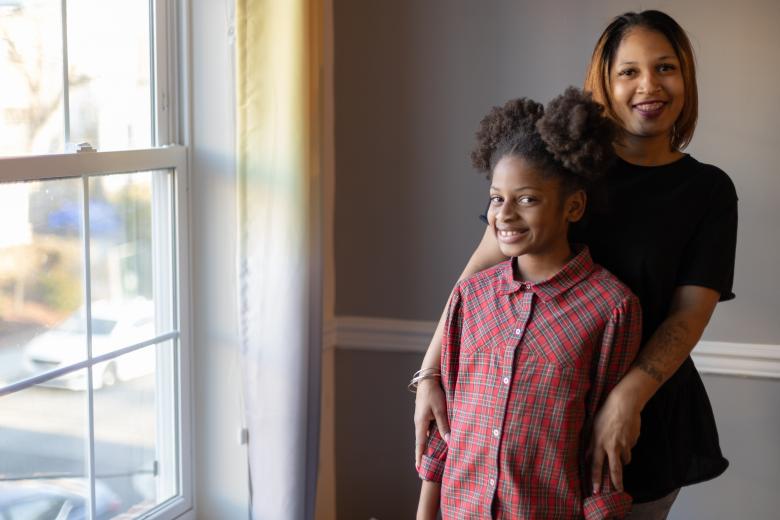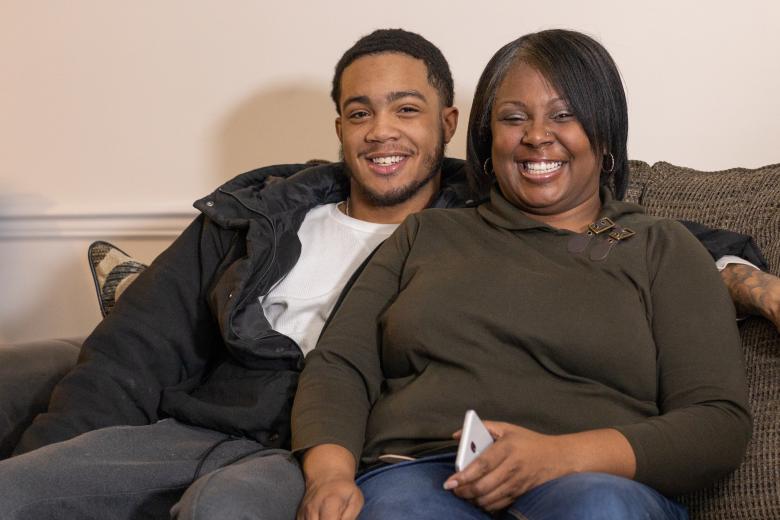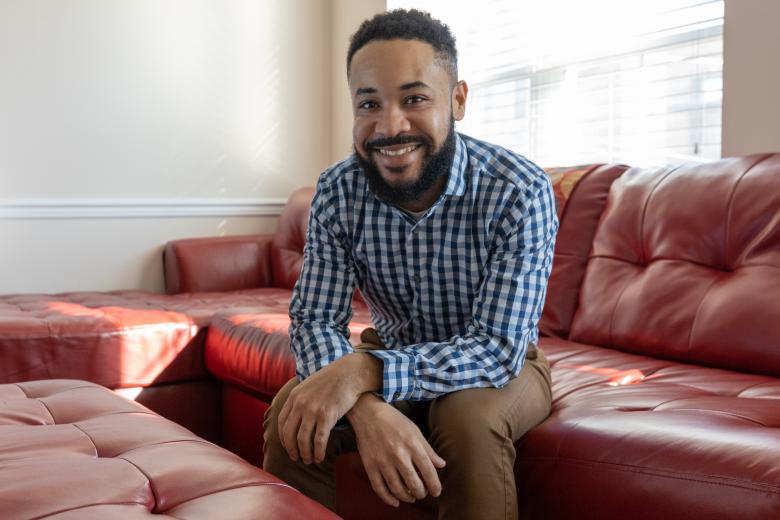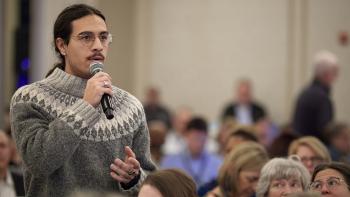
The impact of partnership and advocacy in D.C.
In the U.S. capital, Shawnee beams with pride as her 9-year-old daughter, Miracle, practices her splits and tumbles in the living room of their new townhome in the new Towns at Ivy City development in the historic northeast Ivy City neighborhood.
Her three children are happier here, she says, thanks in large part to the space that the home affords. “It’s space to feel comfortable. To achieve more, faster,” says Shawnee, who is going back to school to become a registered nurse. “And it’s space we can call our own.”

Shawnee and her three children, including 9-year-old daughter Miracle, are happier in their Habitat home.
In the unit below, Tami and a friend set out a game of Scrabble, a favorite pastime, on the kitchen table. Before moving here, she and her 19-year-old son Yancey struggled to find a decent place that they could afford. They had been forced out of a small garden apartment into an even smaller, expensive one-bedroom apartment after flooding and a lingering mold issue left her with asthma. In their new townhome, they not only have their own bedrooms but also peace of mind from finally having shelter that protects their health rather than harms it — including and especially during the coronavirus pandemic.
A few doors down the row of townhomes, Bobby pulls out the ingredients for an egg scramble. Honing his cooking skills has been an unexpected benefit of having a home of his own after years of searching and saving while bouncing between the couches and spare rooms of friends and family. Although employed by the District of Columbia as an IT specialist, soaring home prices meant he couldn’t afford to live in the place where he worked.
Now finally stable in his own home, Bobby feels both more invested and empowered to build up the community around him. He has attended neighborhood meetings, petitioned for the preservation of nearby historic buildings, participated in neighborhood clean-ups. “I feel more connected to my community — which makes me want to give back to it.”
Change through coalition
Shawnee, Tami and Bobby represent three of the 13 families in the Towns at Ivy City development — and 41 in the larger Ivy City neighborhood — that have benefited from an ongoing partnership between D.C.’s Department of Housing and Community Development and Habitat for Humanity of Washington, D.C.

Tami and her 19-year-old son Yancey not only found a stable home with Habitat, but also peace of mind from finally having shelter that protects their health rather than harms it.
The partnership was born out of the need for innovative solutions to Washington’s growing housing crisis. A crisis sparked by very limited, thus costly, land — the entirety of D.C. spans only 68 square miles — and stoked by a history of exclusionary zoning restrictions placed on that land, which determine where housing can go and how dense it can be.
“We don’t have the opportunity to grow outward like a lot of other cities with suburbs because we’re fairly constrained and small,” explains Gene Bulmash, manager of the inclusionary zoning program at DHCD. “As a result, housing is a challenge. And we would not be able to do as much to produce and preserve affordable housing without partners like Habitat for Humanity.”
One of the ways that the two organizations work together is through DHCD’s Inclusionary Zoning Program, which mandates that most new housing developments, and some renovated, must make a certain percentage of their rental units affordable and available only to families making between 50-80% of the area median income.
“The problem in Washington, D.C., is that most developers right now are building one-bedroom and studio rental units. They’re not building family-sized units, and they’re not at all meeting the need for homeownership,” explains Susanne Slater, president and CEO of D.C. Habitat. While affordable rentals are imperative to helping low-income families get ahead, she says that the opportunity to build equity through homeownership is crucial to helping them stay there. “So we partner with the government and with private developers to make that happen,” she says.
“Homeownership is transformational, both for individuals and communities. Health outcomes improve, children do better in school, it stabilizes neighborhoods because people are more concerned and more engaged.”— Susanne Slater, president and CEO of D.C. Habitat
For the Towns at Ivy City development, D.C. Habitat earned approval from the D.C. Zoning Commission to work directly with the developer of a new luxury apartment complex. Together, they used the money earmarked for the creation of the handful of small affordable rentals required by the Inclusionary Zoning Program and, at the same cost, were able to create even more and even larger units that families can own. As an additional effect of financial support of the private-public-nonprofit coalition, D.C. Habitat was able to extend these homeownership opportunities to families making as low as 30% AMI — well below their homeownership program’s minimum income threshold, which is set in place to ensure families can make their monthly mortgage payment.
“The Towns at Ivy City is a perfect example of expanding the reach of our work through partnership,” says Bulmash. “Together, we were able to get larger affordable units at a deeper affordability level — which is vital to maintaining the diversity and quality of the District of Columbia.”
Advancement through advocacy
In addition to working closely with local housing agencies to build, D.C. Habitat has teamed up with partners to help more families access opportunities like these through advocacy. In 2016, alongside the Coalition for Nonprofit Housing and Economic Development, or CNHED, Habitat advocates persuaded the D.C. government to not only reverse planned cuts to the city’s down payment assistance program but nearly double funding to it.
From testifying in front of the city council to organizing rallies for hundreds of affordable housing proponents to make their voices heard, D.C. Habitat’s advocacy, alongside CNHED, resulted in growing the Home Purchase Assistance Program have created a tangible difference in the lives of D.C. residents in need of safe and stable housing like Shawnee, Tami and Bobby. The program, which makes zero-interest home loans and closing cost assistance available to low- to moderate-income homebuyers, reduces the financial barrier of having to save for the traditional sizable down payment while juggling high rents.
“It was impossible to pay the rent, pay for everything else, and then save on top of that,” says Tami. “That HPAP program really, really saved me because without it we wouldn’t have been able to save enough to move into a home of our own.”

“I feel more connected to my community — which makes me want to give back to it,” Bobby says.
“Habitat allowed me to own a piece of something that otherwise would have been out of reach for me,” echoes Bobby. “Their partnerships and programs with the District gave me a chance to live where I work. To make a way where there wasn’t one.”
In addition to helping residents, the down payments assisted by HPAP come to D.C. Habitat as cash at settlement — which allows them to roll the funds back into the mission and to partner with more families in need of the hand up that the homeownership program provides.
“Homeownership is transformational, both for individuals and communities. Health outcomes improve, children do better in school, it stabilizes neighborhoods because people are more concerned and more engaged. But opportunities for low-income families are limited,” says Slater. That’s where advocacy comes in. “It improves lives by affecting change at a fundamental level. It helps us help so many more families thrive.”
